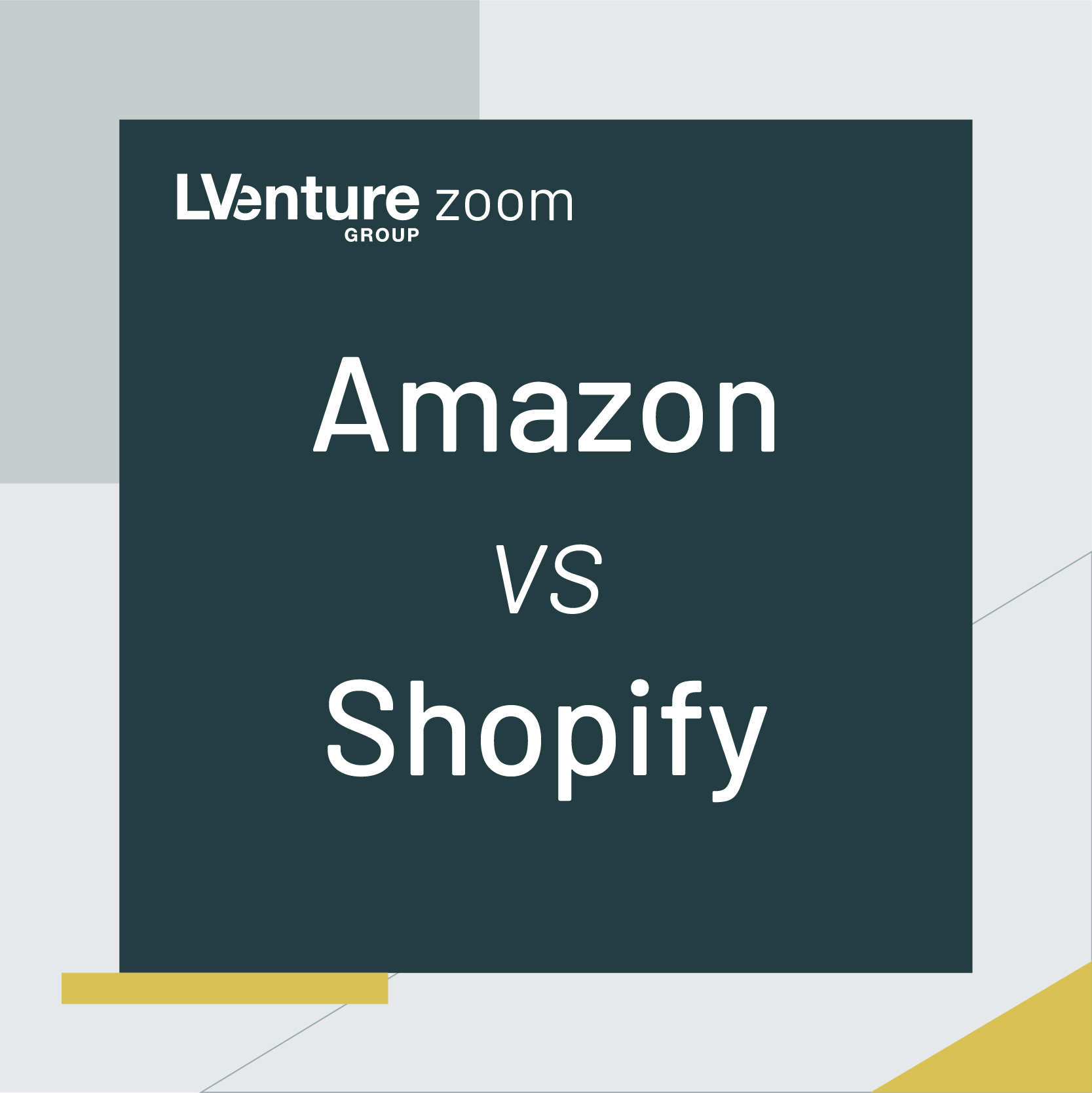The main question is: does Shopify compete against Amazon? To be someone’s competitor you need to share the same market. But it is difficult to find the real boundaries of a market: those change rapidly and for tech, the only real boundaries always remain the regulatory systems. The former argument follows this one: a tech company addressing a market is much more similar to a new paradigm breaking, just as Kuhn presented this notion in his influential book The Structure of Scientific Revolutions.

Following this path to reach a revolutionary phase you need to set new habits, and setting habits mean introducing an efficient paradigm. Shopify is proposing a new paradigm, but its efficiency depends on consensus and is supported by different previous achievements.
The consensus is the kind of magic that happens when fixed things made the picture look consistent. The picture we are speaking of here today is retail. Shopify enables the merchants to be online acting as a platform and this is only a part of the whole picture: for Shopify what happens around its platform it’s more strategic than inside. Understanding Shopify’s growth means taking a look at how a platform could leverage its modularity against an integrated aggregator (Shopify and the Power of Platforms).
First, the logistics and secondly, in the present and near future, the advertising and marketing alternatives, will be crucial redefining the force of gravity in the online retail chain. Even in this imagining, fast and effective integrations can be decisive.

Tech and infrastructural advances made by third parties, or direct competitors in the case of Amazon, often act oppositely. What is happening today inside Amazon? The question is wide, and the answer must look at the whole picture: Amazon is splitted, the web is splitted. This picture, designed to frame the agreement between Facebook /Jio in India, could help figure out in a very simplified scheme the scenario (Apple and Google’s privacy “concerns” are reshaping this picture, therefore this simplified map will need to update the squares’ proportions).
What’s happening today inside Amazon? Shira Ovide point in the NYTimes Tech newsletter shows her skepticism regarding Amazon’s plans:
Mostly, I worry that we’ll put too much faith in what may be low-stakes tinkering for tech giants but high-stakes problems for the rest of us. It’s not helpful if some policymakers are holding off on transit projects to see if driverless cars might be the answer to transportation nightmares. (They won’t.)
I write a lot about the power of big technology companies and the harm that can result. But believing tech superpowers have it all figured out can be harmful, too Amazon itself is facing a broad range of challenges, (pg. 4 in the Amazon Annual Report) and net sales – TMM Q4 2020 – show a deep bond with the US domestic market.

Amazon succeeds in fixing its model in the US while in other markets, where the incumbents and the regulatory systems are different, taking a new market share is sometimes extremely expensive (i.e. EU). This is the first point.
Amazon controlled 35% of the US apparel and footwear market in 2018, but just 8% of Western European sales, according to Euromonitor data.
Amazon manages integrated logistics based on proprietary automated fullfillment and parcel delivery. This early competitive advantage has become more like a commodity today as other logistics operators are improving their model by leveraging a mature technology stack. Ocado, a UK-based tech grocery company, and Fabric, an Israeli startup, today set the bar improving new standards for the medium and small-sized fully automated fullfillment center, reducing the processing costs of orders by up 75%.
In this area, investing in fullfillment sites, like Shopify is planning to, and then offering a viable delivery platform by leveraging the operational maturity of other different actors (3PLs) could be an important alternative to more exclusive models.


The European market is quite different from the US one, and many competitors are fastly improving the delivery chain in the missing parts, providing services increasingly comparable to Prime. This gives new impetus to the potential of those who want to sell directly and/or from platforms such as Shopify.
Europe’s large and regulated market is also redefining a new standard for internal cross-border. With these adjustments, online platforms, such as Shopify who is leading the wave, are becoming more and more valuable, also thanks to the refinement of the logistic chain.
Amazon’s share in parcel delivery is significant, but the competition is alive and can rely on a complex scenario.


The Italian domestic market whit Poste Italiane is an example of this trend: the acquisition of Milkman and the exclusive JV with Sennder are important strategic signals in a rapidly settling national scenario. Behind Amazon PI is the second player for growth.

Reliable logistics is a standard for any e-commerce today. Behind the scenes, at the second level, the technology stack that is making reliable logistics possible has already entered a “commodity era”, positioning automation as a paradigm.
This is the first important point to understand how new standards shift habits, improving new social models. While Amazon “Announces financial result and CEO transition”, February 02, 2021, the Q3 2021 shows those rates:
– Revenue up 37%
– Net income up 200%
– AWS up 29%
– Subscriptions up 33%
– ‘Other’ up 51%
– North American sales up 39%
– International sales up 37%
From this results Amazon’sgrowth shows an interesting focus on “other” (Ads), and as Benedict Evans notes:
There are a few interesting things to think about here. Amazon’s own ecommerce, which is, again, only 40% of actual sales on the site, increasingly looks like a low-margin anchor to support the marketplace, and now ads.

If we assume that advertising comes mainly from the 3P Marketplace and that the negative cash flow is related to this, another interesting insight pointing to this further evolution:
One important question we get asked is whether negative working capital has any downsides? And like many factors in investing, it’s great when things are going well, but can turn toxic in a downturn. Supermarkets have negative working capital as do many construction companies. If a supermarket chain has to close a store, there is a cash outflow; when the store was opened the customers pay for the stock before the supplier has to be paid; the reverse happens when the store is closed.
Similarly, when a construction company completes a contract, it needs to find a new contract immediately, otherwise cash received from its customer will have to be paid out to sub-contractors, and its “float” will decline. This is why construction companies often bid aggressively for new contracts when economies slow. It may be hard to envisage growth at Amazon reversing, but a slowdown in growth would therefore be amplified at the level of free cash flow generated. But it would likely continue to boost cash rather than reverse –
Amazon is in a much stronger position than a construction company or a travel company. We have seen with Covid just how difficult the unwinding of advance payments can be in that industry.
This is indeed an opportunity and money are landing on the Amazon marketplace, from ModernRetail:
But new Amazon seller funding models are becoming major businesses. In November, Thrasio backed an Amazon-seller-focused venture capital firm, Yardline, which is starting out with $10 million in its coffers. Another new entrant, AccrueMe, invests in Amazon sellers in exchange for a temporary profit-share of between 5% and 25%, until the seller can pay the company back. Despite having made less than 30 investments so far, according to the founders, AccrueMe has raised $100 million to put toward future cash infusions for Amazon sellers — all of it from a New York City hedge fund that AccrueMe declined to disclose.
Most acquirers offer sellers the same deal. They’ll take control of top-selling Amazon products from smaller third-party sellers in exchange for a buyout, usually in the high six figures or low seven figures. Then they add those products to their massive portfolios, and they tap into their financial resources to turn them into veritable hits
This could point to a deeper standardization of the products offered by Amazon? with an initial increase in negative cash flow and collections from advertising for the improvement of the model lead by those investors.
These growing ancillary businesses have real consequences for both sellers and consumers. Seller acquirers and VCs tend to use similar tricks for finding and optimizing products — including redesigning product pages, reshooting product photos, adding keywords and so on.
“I worry about what the Amazon Marketplace is going to become with all these copycat mass-market products,” said Kiri Masters, founder of Amazon seller agency Bobsled Marketing.
If these acquirers do become the norm, Amazon products might become optimized to the point of indistinction. “I’ll be looking for an aroma therapy diffuser, and the first ten results look exactly the same,” said Masters. “Where’s the innovation going to be coming from?” She added, “They’re all just copying each other in this SEO circle jerk.”
For consumers, that might turn the Amazon Marketplace — and especially the products that the Amazon algorithm indexes the highest — into a uniform canvas.
Standardization, less choice, and fewer opportunities for small merchants could also mean an impoverishment of the aggregator function of Amazon’s marketplace with a decrease in navigation time and partial loss of the platform aggregator function. Losing aggregation means losing Ads.

A decrease in the chance of having honest performances by smaller and unstructured merchants could lower the final competition in excelling in internal searches with relative spending in ads, while the maturity of other sales channels and an outside reliable logistics would give less chance to Amazon in forcing merchants retention without a valid alternative proposition.
Advertising and Ads mean “aggregator”. Shopify is merely a platform but manages brands, and brands are valuable for aggregators. Brand appeal, the social implication of a product and its choice, is not a mere idea but a real chance, when it works, of a wider marginal earning for the producer and even more if they can go direct.


There is a valuable difference between different types of products: some products could express an added value related to their social value and could be pushed with Ads, but not with “common Ads” on anonymous aggregators, and Amazon doesn’t work well for that kind of branded cultural category. Instagram fits them better for example.
Amazon is slowly shaping its marketplace as a common store for common products, and this is a problem not directly correlated with its policy or strategy, but with the logistics as commodity era. Nike was the progenitor, and the advancement of technology and infrastructure is inversely proportional to the size of those who can afford this divorce.
This picture in a fragmented and competitive market, such as Europe, is more evident.
As a result, while Shopify signed with Facebook an agreement to share its product/brands portfolio with their aggregated customers and is planning to build its fullfillment network to dig its own moat, Amazon, relying on its established positions as an aggregator, is facing the importance of Ads as a higher revenue stream, while fulfillment costs and direct retail costs rise. Amazon in February 2021 bought Selz.
If a recent deal is any indication, e-commerce behemoth Amazon (NASDAQ:AMZN) is looking beyond its own online platform for growth. Australian-based Selz quietly reported last month that it’s signed an agreement to sell itself to the online shopping giant. Selz helps small companies establish and manage their own e-commerce presence, a la Shopify (NYSE:SHOP) or BigCommerce (NASDAQ:BIGC).
Shopify preserves the independence of the retailers and brands; EU logistics is rising just while Amazon’s conquest of Europe is far from assured and web Ads are roaring. In a regulated and plural market as the European one, new layers between consumer and a direct and independent offer could find a place to build confidence over the well-established paradigm “online is the new retail dimension”.
The European market could also act an important role for Amazon in planning its future, trying to leverage its role as an aggregator while pushing on its core as a standard products supplier and finding a way to expand its Ads business. Benedict Evans on Shopify:
The interesting question for Shopify is how far it can move from being a tool to becoming a network, and to become part of retail. And so (to close the loop), the idea that all of this will be swallowed by Amazon makes about as much sense as the idea that all physical retail would get swallowed by Walmart, not because of software but because of retail. So perhaps software isn’t eating retail – retail is eating software.
But on the other hand, the even more interesting question is what Amazon will do to exploit its potential as an aggregator. Behind the scenes, Besoz’s Washington Post launched Arc Publishing, a DXP platform for
- A valuable link.
Millennials and Gen Z desire and deserve more than today’s experiences. The paths to fix the roads to engage those audiences are wide open: cookies are fading while a new world is building its legacy over aggregator’s shoulders. E-commerce is changing radically, and today’s embryonic and boring form will not last for long.
In the charts below is some interesting insights:






















